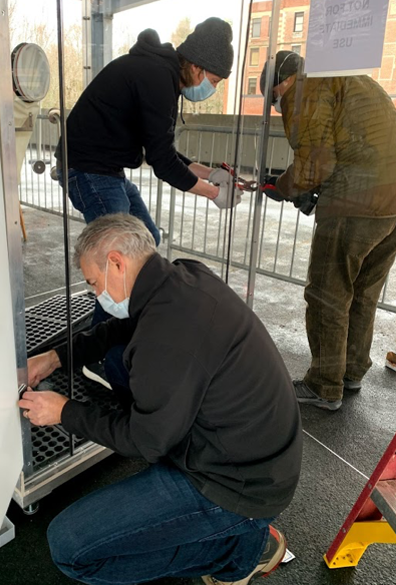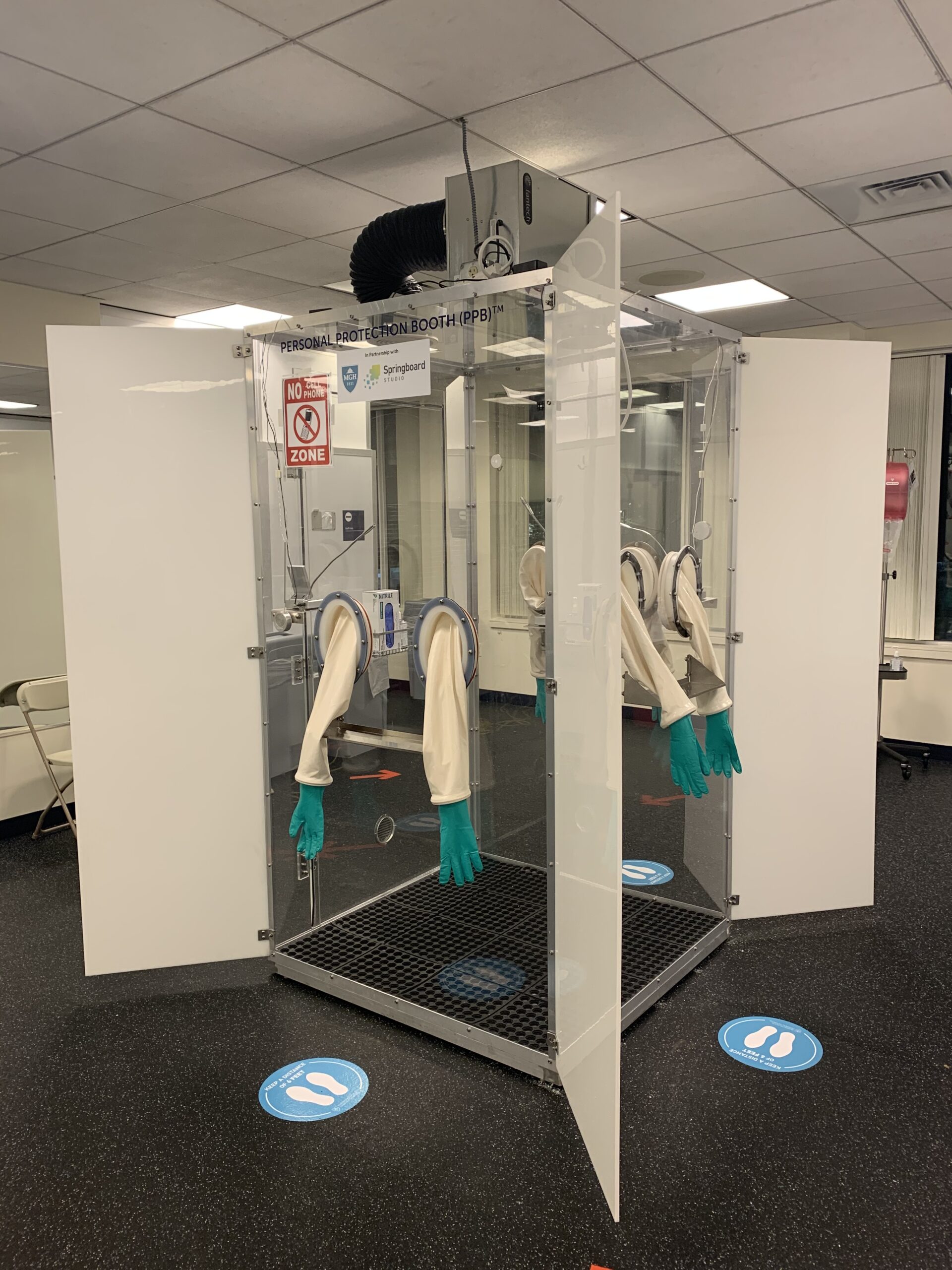The Challenge
In March 2020, Mass General Brigham leadership asked the Springboard Studio to help the health system increase COVID-19 testing capacity and decrease use of personal protective equipment (PPE).
The Solution
The Hexapod Personal Protective Booth increased COVID-19 testing capacity by as much as 354%, while decreasing the use of PPE up to 97% and reduced the cost-per-test.
Project Partners—
ELEVEN; Health Innovation Partners (HIP); MGH Chelsea HealthCare Center; MGH Laboratory Support Services
Services
Design Research, Prototyping, Practical Implementation Support, Measurement & Impact
Year
2020
Specials Thanks to—
Amy Israelian, NP; Paul Currier, MD;
Defining the Challenge
The world had little understanding of the impact of Covid-19 in March 2020. As testing demands increased, personal protective equipment (PPE) was in short supply which left healthcare providers with a growing challenge to test patients safely and efficiently. Mass General Brigham (MGB) leadership knew the testing process was untenable and sought out innovative solutions. They were inspired by a Youtube video of an enclosed testing booth in South Korea and reached out to Kris Olson, MD, MPH, and VP of Design Impact at the Springboard Studio asking if a similar booth could be made to meet our needs here. Dr. Olson’s experience innovating for low-resource settings around the world made him the perfect candidate for addressing this challenge along with our Springboard team. The health system leadership’s objectives were three-fold: 1) reduce use of PPE, 2) increase efficiency in testing, and 3) reduce the risk of transmission between patient and provider.
With South Korea’s testing booth as our North Star and with little else to go off than the Youtube video, our Springboard team began to investigate. From the video, it appeared that a person about to get tested would walk into the booth, while a healthcare provider would administer the test from the outside, using gloved armholes that were attached to the booth and a phone to communicate.

(Left) An early booth prototype is assembled before testing with healthcare providers.
(Below) An early booth prototype is tested with testing subject (played by nurse) inside the booth and the healthcare provider on the outside. With insights from our end-users, the workflow was later flipped to have testing subjects on the outside, with a healthcare provider on the inside.

The booth is tested further to ensure it is accessible to a wide range of end-users.

Design Research & Co-Design
On a whim, we emailed the CEO of the South Korean hospital and to our delight he emailed back quickly with answers to our questions, providing our team enough information to start designing a testing booth of our own. Collaboration became critical to our success and we partnered with product design agency Eleven in Boston. In addition, we worked with Healthcare Innovation Partners, a new company set up for this purpose to both engage local manufacturing otherwise dormant due to the pandemic and to focus on parts sourcing during this period of critical supply chain distruption. We worked closely with Infection Control to test and understand the materials that could withstand frequent disinfection.
As we focused on our local collaborations, we faced challenges acquiring the necessary materials due to the global supply chain—the last material part to arrive was the ‘bank style’ intercoms that would allow for communication between those inside and outside the booth.
As we continued to prototype based on the initial South Korean design, we engaged frontline healthcare workers including a nurse champion who recognized that having a patient inside the booth would actually slow down her testing workflow. The observation led to a significant re-design in both workflow and structure: the testing staff would now stand inside the booth while testing subjects would stand outside. Not only did this reduce the amount of PPE required, but it also allowed for three sides of the rectangular booth to be for testing subjects and eventually led to the booth’s name, Hexapod, because of the six arm sleeves that hang out of the pod. By engaging our end-users so closely in this iterative process, we ultimately were able to develop a product that fit their specific needs, making it more sustainable and effective.
By the Numbers—
Decreased use
of PPE by
97%
First Hexapod
was in use in
28
days
Increased testing
capacity up to
354%
Each booth saved
the health system
$1M
per year
Impact
Nine days after the initial communication with MGB leadership, we had the first prototype for testing at Newton Wellesley Hospital. By day 27, we had completed the redesign and testing and it was ready for use. With data signaling a higher prevalence of Covid-19 within communities of color, our first Hexapod was put into workflow at MGH Chelsea Healthcare Center, with an indoor and outdoor location. Within two weeks, we had 6-7 Hexapods in operation in Respiratory Illness Centers, including an ambulance bay that was used as a testing site at MGH’s Main hospital. The last Hexapod in use was sunset in January 2023, nearly 3 years after its first use.
With Hexapods in place, we were able to measure their impact by pulling data from Epic. We found that the Hexapod led to reduced use of PPE by 97%, increased efficiency in testing by up to 354%, and reduced the cost-per-test. Because of these efficiencies and cost savings, each Hexapod booth saved an average of $1M per year for the health system. The Hexapod’s success would not have been possible without the collaboration and engagement of critical stakeholders and end-users. In April 2023, about three years after the first Hexapod was put into operation, the Springboard team received the Nathaniel Bowditch Award from the Massachusetts General Hospital Board of Trustees, which recognizes significant contributions to improving quality of care while reducing costs.

A deployed Hexapod at MGH Waltham
Learn More—



